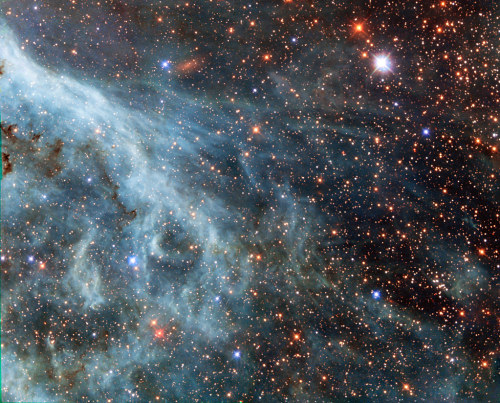The Planet Jupiter






The planet Jupiter
More Posts from Shibushiuniverse and Others

This is the North America Nebula! 🌎🌎🌎
Although the thick dust of this nebula makes it opaquely red, the use of infrared telescopes reveal a beautiful stellar landscape underneath. Stretching across 50 light years, this nebula contains thousands of young, hot stars that heat up the surrounding gas and make it emit its amazing colors! 💥💥💥
Taken by me (Michelle Park) using the Slooh Canary One telescope on May 26th, 2022 at 4:33 UTC.
✘ ✘ ✘ ✘ ✘ ✘ ✘ ✘ ✘ ✘ ✘ ✘ ✘ ✘ ✘ ✘ ✘ ✘ ✘ ✘ ✘ ✘ ✘ ✘ ✘ ✘








✘ ✘ ✘ ✘ ✘ ✘ ✘ ✘ ✘ ✘ ✘ ✘ ✘ ✘ ✘ ✘ ✘ ✘ ✘ ✘ ✘ ✘ ✘ ✘ ✘ ✘




Spatial veils of light






"space exploration" by eren arik

NGC 6995: The Bat Nebula : Do you see the bat? It haunts this cosmic close-up of the eastern Veil Nebula. The Veil Nebula itself is a large supernova remnant, the expanding debris cloud from the death explosion of a massive star. While the Veil is roughly circular in shape and covers nearly 3 degrees on the sky toward the constellation of the Swan (Cygnus), NGC 6995, known informally as the Bat Nebula, spans only ½ degree, about the apparent size of the Moon. That translates to 12 light-years at the Veil’s estimated distance, a reassuring 1,400 light-years from planet Earth. In the composite of image data recorded through narrow band filters, emission from hydrogen atoms in the remnant is shown in red with strong emission from oxygen atoms shown in hues of blue. Of course, in the western part of the Veil lies another seasonal apparition: the Witch’s Broom Nebula. via NASA
-
 aernirose reblogged this · 1 month ago
aernirose reblogged this · 1 month ago -
 koshigurajumy liked this · 1 month ago
koshigurajumy liked this · 1 month ago -
 someforgottonstreet liked this · 1 month ago
someforgottonstreet liked this · 1 month ago -
 maromisdream reblogged this · 1 month ago
maromisdream reblogged this · 1 month ago -
 theranman reblogged this · 1 month ago
theranman reblogged this · 1 month ago -
 theranman liked this · 1 month ago
theranman liked this · 1 month ago -
 intergalactic-author reblogged this · 1 month ago
intergalactic-author reblogged this · 1 month ago -
 harshethic reblogged this · 1 month ago
harshethic reblogged this · 1 month ago -
 harshethic liked this · 1 month ago
harshethic liked this · 1 month ago -
 cha0ticf0x liked this · 1 month ago
cha0ticf0x liked this · 1 month ago -
 lovemusicnart reblogged this · 1 month ago
lovemusicnart reblogged this · 1 month ago -
 lovemusicnart liked this · 1 month ago
lovemusicnart liked this · 1 month ago -
 eclectic-like-furniture reblogged this · 1 month ago
eclectic-like-furniture reblogged this · 1 month ago -
 eclectic-like-furniture liked this · 1 month ago
eclectic-like-furniture liked this · 1 month ago -
 farewelltomediocrity reblogged this · 1 month ago
farewelltomediocrity reblogged this · 1 month ago -
 rodrigogirdor reblogged this · 1 month ago
rodrigogirdor reblogged this · 1 month ago -
 lastoftheptolemies reblogged this · 1 month ago
lastoftheptolemies reblogged this · 1 month ago -
 witchypurpleraven reblogged this · 2 months ago
witchypurpleraven reblogged this · 2 months ago -
 witchypurpleraven liked this · 2 months ago
witchypurpleraven liked this · 2 months ago -
 countessravengrey reblogged this · 2 months ago
countessravengrey reblogged this · 2 months ago -
 countessravengrey liked this · 2 months ago
countessravengrey liked this · 2 months ago -
 antimony-ore reblogged this · 2 months ago
antimony-ore reblogged this · 2 months ago -
 antimony-ore liked this · 2 months ago
antimony-ore liked this · 2 months ago -
 corrupted-starcharts reblogged this · 2 months ago
corrupted-starcharts reblogged this · 2 months ago -
 masteroftheyellowrabbit-blog liked this · 2 months ago
masteroftheyellowrabbit-blog liked this · 2 months ago -
 calm-is-a-superpowerr reblogged this · 2 months ago
calm-is-a-superpowerr reblogged this · 2 months ago -
 yharnamesque reblogged this · 2 months ago
yharnamesque reblogged this · 2 months ago -
 a-john-hughes-film liked this · 2 months ago
a-john-hughes-film liked this · 2 months ago -
 fangmich reblogged this · 2 months ago
fangmich reblogged this · 2 months ago -
 chalium liked this · 2 months ago
chalium liked this · 2 months ago -
 bellaralutare liked this · 2 months ago
bellaralutare liked this · 2 months ago -
 doppelgangerleaverite reblogged this · 2 months ago
doppelgangerleaverite reblogged this · 2 months ago -
 esquie reblogged this · 2 months ago
esquie reblogged this · 2 months ago -
 ginger-old-wyrm reblogged this · 2 months ago
ginger-old-wyrm reblogged this · 2 months ago -
 ginger-old-wyrm liked this · 2 months ago
ginger-old-wyrm liked this · 2 months ago -
 engelart liked this · 2 months ago
engelart liked this · 2 months ago -
 zoeflake liked this · 2 months ago
zoeflake liked this · 2 months ago -
 pinayprincessvixen liked this · 2 months ago
pinayprincessvixen liked this · 2 months ago -
 random-animals reblogged this · 2 months ago
random-animals reblogged this · 2 months ago -
 aimlessdriftwood reblogged this · 2 months ago
aimlessdriftwood reblogged this · 2 months ago -
 aimlessdriftwood liked this · 2 months ago
aimlessdriftwood liked this · 2 months ago -
 uncovering-the-fetish reblogged this · 2 months ago
uncovering-the-fetish reblogged this · 2 months ago -
 last-rexistance liked this · 2 months ago
last-rexistance liked this · 2 months ago -
 vulgarpicturestwo liked this · 2 months ago
vulgarpicturestwo liked this · 2 months ago -
 arytha reblogged this · 2 months ago
arytha reblogged this · 2 months ago










